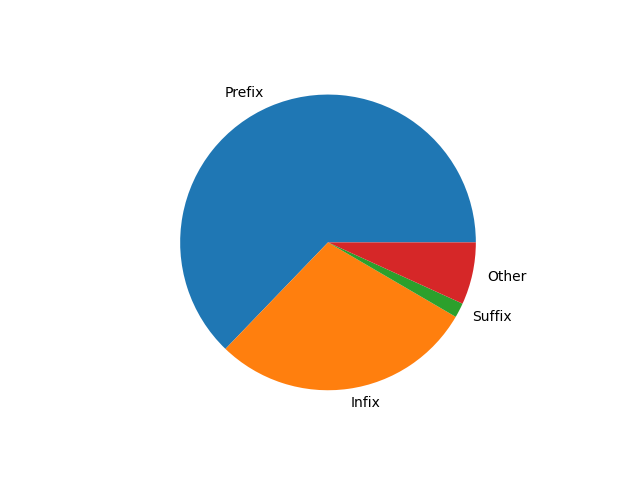The ISO 3166-1 standard defines three codes for each country: a 2-letter abbreviation, a 3-letter abbreviation, and a 3-digit code.
The 2-letter abbreviations may be familiar because it is very often (but not always [1]) also the country code top-level domain (ccTLD). For example, AU is the ISO abbreviation for Australia, and .au is the ccTLD.
I was curious about the relation between the two-letter and three-letter abbreviations. Sometimes the former is a prefix of the latter, such as US and USA. Sometimes the latter adds a letter in the middle, such as going from CN to CHN. How common are these two patterns?
I wrote a script using the iso3166 Python module to find out.
Turns out that the prefix pattern is most common, and occurs 63% of the time.
The infix pattern is the next most common, occurring 29% of the time.
Suffixes are rare. There are only for instances where the 2-letter name is the last two letters of the 3-letter name: ATF, MYT, SPM, and SGS.
The remaining possibilities are miscellaneous relations, such as IL and ISR for Israel.

Here’s a table of countries and ISO codes in plain text (org-mode) format.
[1] There are four ccTLDs that are not ISO 3166-1 alpha-2 names: uk, su, ac, and eu.

And then there are also the three-letter country codes of the IOC :-)
It’s also interesting that 3 out of 4 are french territories.
.uk belongs to the UK of course; their ISO 2-letter code is GB but they asked for .uk for ease of mapping names from their pre-DNS JANET system. .gb also exists but is essentially unused.
.su belonged to the Soviet Union, and then it devolved on Russia rather than being retired, for reasons which mostly amount to “*you* try convincing Russia to do anything”.
.eu is, of course, not a country.
.ac belongs to Ascension Island, which is part of SH (Saint Helena, Ascension, and Tristan da Cunha) in the ISO scheme, but has its own TLD. .sh also exists.
I love this type of post! A while ago I created a spreadsheet comparing the various 3-letter codes for European countries (https://docs.google.com/spreadsheets/d/1SKpekQWGYAuhVDeZxCYgWsv3kCmHx_fSXntJc0FKt-c/edit#gid=0) and identifying where they’re consistent between them and with the simple 3-letter truncation of the country name. Of course, there are exceptions everywhere.